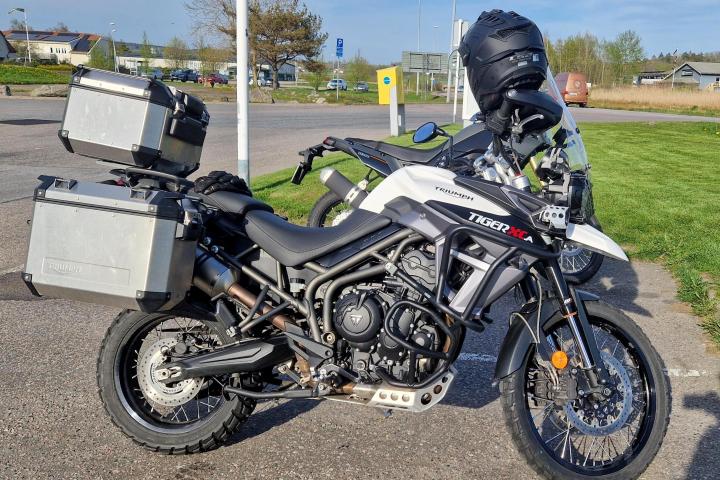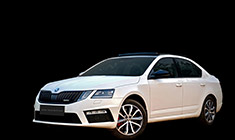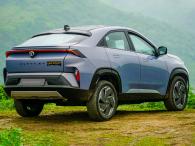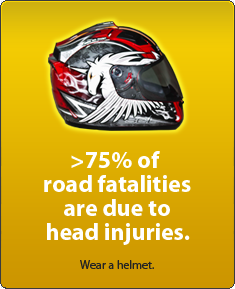News
Bought a Tiger 800 while working to get my Swedish Heavy Motorcycle DL
The school had a bunch of Yamaha models, mostly the MT-07s and a few MT-09s. And I learned that anyone can ride fast but it takes skill to ride slow!
BHPian swe.desi recently shared this with other enthusiasts.
"Avoid cliches like the plague", one of my favorite authors opines.
Therefore, doing as he does and not as he says I quote one such cliche.
Four wheels move the body; Two wheels move the soul!
This aptly captures the 'Why?' behind this journey I embarked upon in October of 2023, approximately seven months ago.
I'm extremely pleased to share my experience of...
The Swedish Heavy Motorcycle A Driving License - (Körkort Motoryckel A)
In a nutshell, the following steps need to be completed to obtain a motorcycle license in Sweden -
- An eye test
- A learner's permit
- Risk 1 (theory on risks associated with riding a motorcycle, causes of accidents, statistics, etc.)
- Risk 2 (riding control, riding in hazardous conditions, obstacle avoidance, weaving, hard braking, etc.)
- Theory Exam
- Practical Exam (Maneuvers and Street Riding)
SuperMax has a superbly detailed post on the process here.
Getting the car license was sensible, but this? This was purely passion. And passions did indeed run high and low, as you will come to read.
The idea of getting a motorcycle license shuffled between the back burner and the deep-freezer several times since I moved to Sweden in the Autumn of 2019. Covid did not help matters any. The odds seemed stacked against me with this one. Consider the following; the riding exam only takes place between May and October, the theory exam is only in Swedish, the examinee has to get their own bike for the exam, lessons with a school are expensive and sell out fast, yada yada!
This was not an easy recipe, but having had enough of excuses and not enough of motorcycling in my life I rolled up my sleeves and started cooking in earnest.
That's the end of kitchen metaphors. I think.
The Chronology
To appear for the practical one has to have passed the Theory. To appear for the theory exam one has to have completed Risk 1 and Risk 2. Risk 1 & and Risk 2 can be done in any order, and they're different from the Risk courses for a Car.
Risk 1 & Risk 2 -> Theory -> Practical -> Licensed to Rev!
In the August of 2023, I realised the need to plan if I wanted my MC license. The riding season of '23 was swiftly coming to a close. If I wanted to appear for the exam in May of '24 I would need to complete Risk 2 before the end of October '23, prepare for the theory through the winter to attempt the exam in March or April of '24, and hope to get an early slot in May. This was the rough plan.
Tick-Tock! The clock was ticking.
A few hours and days of manic googling later I had identified the riding schools in Gothenburg, the prices involved, the Risk 1 providers, the Risk 2 course provider, and the fact that everything was in Swedish. There was absolutely no support for English.
As they say in the Soulsborne circles, it was time for me to "git gud" at Swedish. But that's a different story.
Risk 1
I booked a Risk 1 class which I could attend after work, price and timing were the only considerations here. Since the class was in Swedish, and at this point, I could only understand basic sentences most of the class was spent nodding and frowning intently. Any efforts to communicate from my side were met with confused frowns. There was a serious risk of sprained eyebrows. My attentiveness in the class and participation, pantomimed and flawed as it were, was enough to ensure I cleared the first hurdle. To be fair, it would take serious skill to fail this one.
Prior to taking a Risk 2 I had taken a lesson with a school to understand their perspective on whether I was ready for Risk 2. That was on a BMW 750 GS, and the instructor was happy enough to recommend I go for it. I was happy to be riding after months.
Risk 2
Risk 2 was more straightforward to book. There is only one place in Gothenburg that I'm aware of that offers the course (Stora Holm). I booked the second last course of the year, and as luck would have it, it was a rainy day. The school had a bunch of Yamahas, mostly MT-07s and a few MT-09s. The school also provides all the gear so all I had to do was show up. There were 5 people in all, and after changing into our gear we had a brief which consisted of introductions, some basic safety information, and information on the activities for the day.
Again, I was mostly nodding, pantomiming, or speaking in a deeply mutated form of Swedish. After the brief, we were led onto the course which comprised of riding in different manoeuvres like slalom, u-turns, braking, etc. The instructors watched us and then provided input where needed. We also practised panic braking and tried to activate the ABS on both wheels. All in all it was a really fun time riding the MT07, an extremely refined bike with a very approachable power delivery and seat height. Most riding schools use the MT07 as their learner bikes.
The easy part was done, and I could now appear for the theory exam. I now had all winter to brush up my Swedish and study the theory, just as planned.
So obviously I procrastinated...
I booked the theory exam for the 5th of April, and purchased a three-month membership on one of the license theory portals. These portals provide the theory and practice exams which are similar to the real thing. The idea was to read through the theory and take as many practice exams as possible. The reality was I had to rely heavily on Google Translate, reading every paragraph of the theory once in English, immediately followed by reading in Swedish, making notes of the Swedish words in a wordlist with their English meanings, rinse & repeat. It was long, slow, and arduous process. And never did I feel truly confident. In fact, I had made up my mind to treat the first attempt like a practice test.
In the meantime, I also had to start practising riding. Fortunately, a friend and fellow motorcycle enthusiast volunteered to be my instructor. We registered online & in five minutes we were good to go. All I needed now was a motorcycle to practice riding and to take the exam on.
I had been scouring Sweden's version of eBay called blocket for weeks. I needed a bike with at least a minimum of 595cc volume & 0.25 kW/kg power-to-weight ratio to qualify for the heavy license. This would allow me to ride any motorcycle. However, this also meant that the choices within my budget were severely limited, and coupled with my preference for an off-road biased machine which didn't break my bank every excursion into the land of second-hand deals was akin to a man looking for an oasis in the desert whilst being surrounded by tantalizing mirages.
Eventually, I ended up finding & purchasing this, my Triumph Tiger 800 xCa 2017.

(There will be another post on the whole buying process and we will focus on the license in this one. )
The following weeks were chock-full of work, planning and actually doing the practice riding, home chores, and studying for the theory at night.
The theory exam by far was my main concern. I knew the rules, but not knowing a word or mis-remembering a meaning meant I was getting more answers wrong than I would have liked.
I kept my nose on the grindstone, and soon it was time for the theory exam. Feeling less than confident I gave my attempt. The exam is a multiple-choice question format and I was feeling quite confident. I had blanked on a road sign, and knew I missed a couple of questions but at this point, I was more hopeful than when before I started. Unfortunately, I didn't clear my first attempt. I missed passing by two marks. A quick post-mortem brought me to the realization that I spent more time with the theory in Swedish, and didn't do a revision of the road signs which I thought I knew well enough. Simultaneously over and underconfident.
On the way back home I booked another theory exam a week later. I knew exactly what I had to focus on, and I spent my evenings reading the theory again, making a Swedish word list on my phone with English meanings, and taking as many practice exams as I could. The exam rolled up and this time I passed it. With two marks!
I was elated! In my mind, this was the greatest hurdle and the cat was almost in the bag. Little did I know.
With just four-ish short weeks left before the practical exam, I had to cram in as much practice as possible for the maneuvers part. The riding exam consists of two parts - manoeuvres and city riding. The manoeuvres are slow-speed riding, high-speed evasive and slalom, and high-speed emergency braking. The city riding is where the examiner follows you on their own motorcycle and gives directions over an intercom, and you are judged on road regulations, positioning, navigation, etc. Only after passing the manoeuvres can one proceed for the city riding.
The important thing for me to focus on was the manoeuvres. Since I was learning privately it complicated matters not only from a logistics perspective, and also that we didn't have the best idea of what the examiners were looking for. The schools will teach you the 'right' way of performing the manoeuvres, the things the examiners look for. This came back to bite me in the ass big time.
Talking about logistics, my bike was parked in my friend's garage which made sense since I could only ride when accompanied by him. The problem was he lived 40 kilometers away. On occasions, I would hitch a ride with him after work, get in an hour or two of riding, then take public transport back home. On weekends I would take public transport both ways. This meant a train and a bus ride, which usually added up to an hour each way. After meeting my friend at his place we would ride down to the practice track nearby. This practice area was essentially a dead-end street where the course had been graffitied on to the tarmac.
Coming to the actual riding complications- I had just got a bike completely new to me. Much heavier than my previous ride, a Duke 390, and with very different riding characteristics. The first day of practice was terrible on the slow-speed manoeuvres. My friend instructed me to practice garage turns as slowly as possible without putting my feet down. It went terribly. I had never actually tried to ride slow before. The bike wanted to tip over at every chance, and indeed I did drop it on the first day of practice. Thanks to crash guards it didn't hurt as much as it could have.
Anyone can ride fast, but it takes skill to ride slow.
Eventually, I began to understand the bike better and found the balance and the ever-important precision on the clutch and throttle. The high-speed manoeuvres were better and I quickly got comfortable dancing with the bike on the slalom.
The emergency braking was no problem at all. Accelerate up to 70 kmph and brake as your life depends on it, then do it again from 90.
The evening before the exam we rode down to town and parked the motorcycle at the office garage with an agreement to meet at 7 AM the following day.
I was quite nervous but managed to get a good night's sleep, keeping negative thoughts at bay. Thoughts like, "Oh! You bought an expensive motorcycle before you cleared the exam? That's quite gutsy. Or foolish. Well, better not fail tomorrow or you'll have a bike you can't ride. Alright, sleep well".
It was finally exam day.
Check out BHPian comments for more insights and information.









.jpg)
.jpg)








